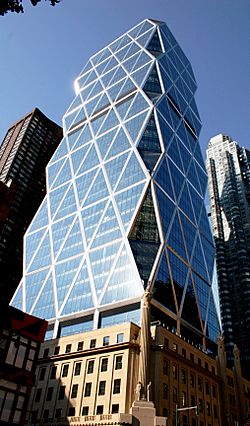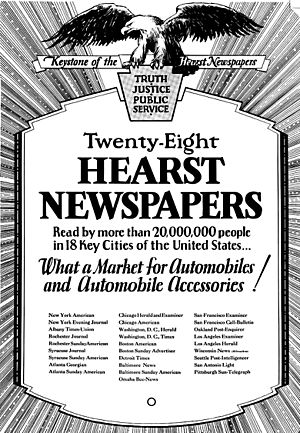Hearst Communications facts for kids
-
- Hearst Corporation
- Hearst Holdings, Inc.
- Hearst Communications, Inc.
Quick facts for kids Logo used since 2016
|
|

Hearst Tower in Midtown Manhattan, September 2006
|
|
| Private | |
| Industry | Media |
| Founded | March 4, 1887 San Francisco, California, U.S. |
| Founder | William Randolph Hearst |
| Headquarters | Hearst Tower 300 W. 57th Street New York, N.Y. 10019 U.S. |
|
Area served
|
Worldwide |
|
Key people
|
|
| Products | Books Magazines Newspapers Publications Television |
| Revenue | |
| Owner | Hearst family |
|
Number of employees
|
22,000 (2024) |
| Divisions |
|
| Subsidiaries |
|
Hearst Corporation is a huge American company. It owns many different types of media businesses. These include newspapers, magazines, and TV channels. The company is owned by the Hearst family. Its main office is in the Hearst Tower in New York City.
Hearst owns popular magazines like Cosmopolitan and Esquire. It also owns major newspapers such as the San Francisco Chronicle and the Houston Chronicle. The company has a big share in TV networks like A&E Global Media (50%) and ESPN (20%).
Besides media, Hearst also owns companies that provide business information. One example is Fitch Group. The company was started by William Randolph Hearst. He was a famous newspaper owner. The Hearst family still plays a big role in running the company today.
Contents
History of Hearst Corporation
How Hearst Started
In 1880, George Hearst bought a newspaper called the San Francisco Daily Examiner. He was a mining business owner and a U.S. senator. In 1887, he gave the newspaper to his son, William Randolph Hearst. That same year, William Randolph Hearst started the Hearst Corporation.
William Randolph Hearst was very good at growing his newspaper business. He increased the number of readers for Hearst newspapers and magazines from 15,000 to over 20 million! He bought and started many other newspapers. These included the New York Journal in 1895 and the Los Angeles Examiner in 1903.
In 1903, Hearst launched Motor magazine. This was the first magazine in his company's magazine division. He also bought Cosmopolitan in 1905 and Good Housekeeping in 1911. Hearst also got into publishing books in 1913. He even started making films in the mid-1910s. He created one of the first animation studios, called International Film Service. This studio turned characters from Hearst newspaper comics into movie characters.
Hearst's Golden Age
In the 1920s and 1930s, Hearst owned the largest media company in the world. It had many magazines and newspapers in big cities. Hearst also started buying radio stations to go along with his newspapers.
During this time, Hearst faced some money problems. He was spending a lot of company money to build Hearst Castle in San Simeon. He also spent money on movie production at Cosmopolitan Productions. This led to some of his magazines merging. For example, Hearst International merged with Cosmopolitan in 1925.
Even with some financial challenges, Hearst kept growing. He bought many more newspapers across the country. These included papers in Detroit, Boston, and Seattle in 1921. He continued buying papers through the mid-1920s. In 1924, Hearst started a tabloid newspaper in New York City called New York Daily Mirror. It was made to compete with the New York Daily News.
Besides print and radio, Hearst also had a film company called Cosmopolitan Pictures. In 1929, Hearst and MGM created newsreels together. These were short news films shown in movie theaters.
Changes After the Great Depression
The Great Depression in the 1930s was a tough time for Hearst and his businesses. He had to sell some parts of his company. For example, his book publishing division was sold in 1931. He also sold some of his newspapers.
After World War II, television news became popular. Also, more people moved to the suburbs. This meant that evening newspapers, which used to be very popular, started to lose readers. Morning papers were less affected.
In 1947, Hearst produced an early TV newscast. In 1948, he became one of the first owners of a television station, WBAL-TV in Baltimore.
Over the years, Hearst continued to make changes to its newspaper business. Some papers merged, and others were sold. For example, in 1956, Hearst sold the Chicago American newspaper. In 1960, he sold the Pittsburgh Sun-Telegraph and the Detroit Times.
In 1958, Hearst's International News Service merged with United Press. They formed United Press International (UPI). This was done to compete with other big news agencies. In 1959, Hearst also bought Avon Books, a paperback book publisher.
In the 1960s, Hearst started making agreements with other newspaper companies. These were called joint operating agreements (JOAs). This allowed different newspapers to share printing and business operations.
Modern Era and New Ventures
Hearst continued to expand its publishing business. It bought hardcover book publishers like Arbor House in 1978 and William Morrow and Company in 1981.
In 1982, Hearst sold the Boston Herald American newspaper. In 1986, Hearst bought the Houston Chronicle. That same year, it closed the Baltimore News-American after a long history.
In 1990, Hearst Corporation bought a 20% share of ESPN. The Walt Disney Company owns the other 80%. This investment in ESPN has been very successful for Hearst.
Hearst also got into digital media. In 1995, it invested in Netscape Communications. In 1996, Hearst launched a Latin American animation TV channel called Locomotion.
In 1997, Hearst's broadcasting division merged with Argyle Television. This created Hearst-Argyle Television, which was later renamed Hearst Television in 2009.
In 1999, Hearst sold its Avon and Morrow book publishing businesses. In 2000, Hearst sold its San Francisco Examiner newspaper. It then bought the San Francisco Chronicle, which was a long-time competitor.
Hearst continued to grow by acquiring other companies. In 2006, it bought a share in Fitch Group, a global financial services company. Hearst later owned 100% of Fitch Group by 2018. In 2009, Hearst's ownership in A&E Networks increased to 42%.
In 2010, Hearst bought iCrossing, a digital marketing agency. In 2011, Hearst acquired over 100 magazine titles from the Lagardère Group. This made Hearst a major player in the magazine world. In 2012, Hearst partnered with NBCUniversal to launch Esquire Network.
Hearst has continued to make new acquisitions in recent years. In 2017, it bought a majority share in Litton Entertainment, which creates syndicated TV programming. Litton Entertainment was renamed Hearst Media Production Group in 2022. Hearst also bought several local newspaper groups in Michigan and Illinois in 2017. In October 2017, Hearst announced it would acquire the magazine and book businesses of Rodale, Inc..
In April 2023, Hearst bought WBBH-TV, a TV station in Florida. In June 2023, Hearst acquired the Journal Inquirer newspaper. In October 2023, it bought San Antonio Magazine. In November 2023, Hearst acquired all print and digital operations owned by RJ Media Group. In December 2023, Hearst bought Puzzmo, a puzzle games website.
In April 2024, Hearst acquired the Texas magazines Austin Monthly and Austin Home. A new group called Hearst Texas Austin Media was created to manage these titles. In December 2024, Hearst bought a majority of the Motor Trend Group. This includes popular magazines like Motor Trend and Hot Rod.
In August 2024, Hearst announced it would acquire QGenda. This company provides software for managing healthcare workers. QGenda became the sixth business in the Hearst Health division. In July 2025, Hearst announced its purchase of Dallas Morning News.
Leaders of Hearst Corporation
- In 1880, George Hearst started in the newspaper business.
- On March 4, 1887, his son, William Randolph Hearst, became the editor and publisher of the San Francisco Examiner. He led the company until he passed away in 1951.
- After William Hearst, Richard E. Berlin became CEO in 1951. He retired in 1973.
- From 1973 to 1975, Frank Massi was president. He helped reorganize the company's finances.
- From 1975 to 1979, John R. Miller was president and CEO.
- Frank Bennack served as CEO and president from 1979 to 2002. He returned as CEO from 2008 to 2013.
- Victor F. Ganzi was president and CEO from 2002 to 2008.
- Steven Swartz has been president since 2012 and CEO since 2013.
Current Group Leaders
- Debi Chirichella became president of Hearst Magazines in 2020.
- Jeffrey M. Johnson became president of Hearst Newspapers in 2018.
- Michael J. Hayes became president of Hearst Television in 2023.
- Greg Dorn is president of Hearst Health.
- Tom Cross became president of Hearst Transportation in 2021.
- Paul Taylor is the chief executive officer of Fitch Group.
What Hearst Owns
Hearst owns many different companies and investments. Here is a list of some of them:
Magazines
- Bicycling
- Car and Driver
- Cosmopolitan
- Country Living
- ELLE (US and UK)
- ELLE DECOR
- Esquire
- Food Network Magazine
- Good Housekeeping
- Harper's BAZAAR
- HGTV Magazine
- Hot Rod
- House Beautiful
- Men's Health
- Motor Trend
- Oprah Daily (digital)
- The Pioneer Woman Magazine
- Popular Mechanics
- Prevention
- Redbook (digital)
- Road & Track
- Runner's World
- Seventeen (digital)
- Town & Country
- VERANDA
- Woman's Day
- Women's Health
- Hearst Books
Newspapers
- San Francisco Chronicle (San Francisco, California)
- SFGate (San Francisco, California)
- Hearst Connecticut newspapers:
- The News-Times (Danbury)
- Greenwich Time (Greenwich)
- The Advocate (Stamford)
- Connecticut Post (Bridgeport)
- Journal Inquirer (Manchester)
- Record-Journal (Meriden)
- The Middletown Press (Middletown)
- New Haven Register (New Haven)
- The Hour (Norwalk)
- The Register Citizen (Torrington)
- Many weekly newspapers in Connecticut
- The Telegraph (Alton, Illinois)
- Edwardsville Intelligencer (Edwardsville, Illinois)
- Jacksonville Journal-Courier (Jacksonville, Illinois)
- Huron Daily Tribune (Bad Axe, Michigan)
- Pioneer (Big Rapids, Michigan)
- Manistee News Advocate (Manistee, Michigan)
- Midland Daily News (Midland, Michigan)
- Times Union (Albany, New York)
- Austin-American Statesman (Austin, Texas)
- Beaumont Enterprise (Beaumont, Texas)
- Houston Chronicle (Houston, Texas)
- Chron.com (Houston, Texas)
- Laredo Morning Times (Laredo, Texas)
- Midland Reporter-Telegram (Midland, Texas)
- Plainview Daily Herald (Plainview, Texas)
- San Antonio Express-News (San Antonio, Texas)
- MySA (MySanAntonio.com) (San Antonio, Texas)
- Seattle Post-Intelligencer (Seattle, Washington)
Broadcasting and TV
- A+E Networks (Hearst owns 50% with Disney)
- ESPN, Inc. (Hearst owns 20% with Disney)
- Hearst Television (owns 29 local TV stations and 2 radio stations)
- Hearst Media Production Group (creates TV shows for syndication)
- Motor Trend (TV network)
Internet Businesses
- BestProducts.com
- Clevver
- Delish.com
- Digital Spy
- NetDoctor
- Puzzmo
Other Businesses
- Black Book (National Auto Research) (car pricing info)
- CAMP Systems (aircraft maintenance)
- CDS Global (magazine subscription services)
- First Databank (healthcare info)
- Fitch Group (financial ratings)
- Homecare Homebase (home healthcare software)
- iCrossing (digital marketing)
- Jumpstart Automotive Group (car advertising)
- King Features Syndicate (comic strips and puzzles)
- KUBRA (customer communication)
- LocalEdge (digital advertising)
- Map of Medicine (healthcare guidelines)
- MCG Health (healthcare guidelines)
- ODG by Workloss Data Institute (disability guidelines)
- Zynx Health (healthcare info)
Trustees of William Randolph Hearst's Will
William Randolph Hearst's will set up a special group of thirteen trustees. These trustees manage the Hearst Foundation, the William Randolph Hearst Foundation, and the trust that owns the Hearst Corporation. Five of these trustees are family members, and eight are not. This setup helps manage the company for the long term.
The trust will continue until all family members who were alive when William Hearst passed away in August 1951 have also passed away.


